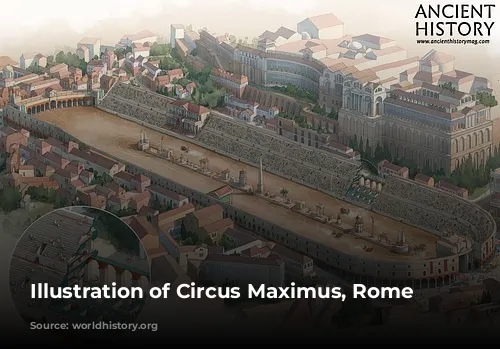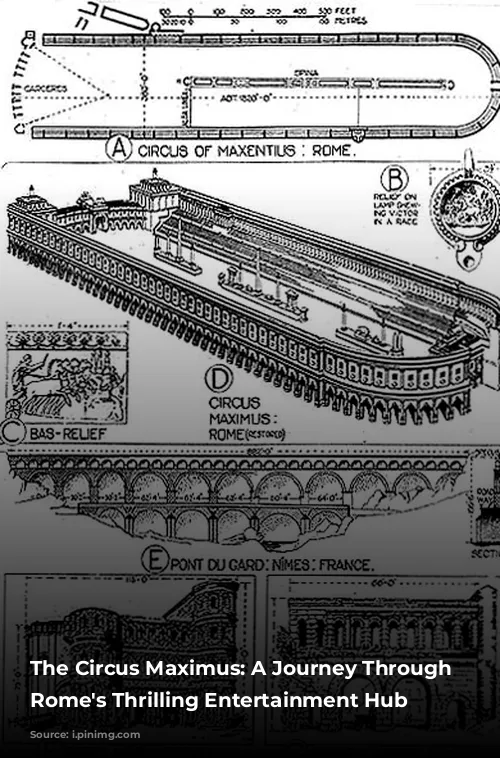Imagine a massive stadium, stretching out before you, bustling with thousands of excited spectators. This wasn’t just any arena; it was the Circus Maximus, the heart of entertainment in ancient Rome. Built in the 6th century BCE, this grand spectacle served as the epicenter of chariot racing, gladiator battles, and other public events that captivated the Roman Empire.
![Circus Maximus [Present Day]](https://rometravelguide.info/wp-content/uploads/2024/09/the-circus-maximus-a-journey-through-ancient-rome-s-thrilling-entertainment-hub_172603834554955.webp)
A Legacy of Kings and Emperors
The Circus Maximus boasts a history as rich as its sprawling design. Legend whispers that it was first conceived by the first Roman kings in the 6th century BCE. However, it was under Julius Caesar that the Circus truly took shape, evolving into the iconic structure we know today. Its primary purpose was to host spectacular chariot races and the Ludi Romani, games honoring Jupiter, the king of the gods. Held every September, these events included 15 days of thrilling races, military parades, and extravagant festivities.
Beyond chariot races, the Circus Maximus was a stage for a multitude of events:
- Wild animal hunts, showcasing the might of Roman conquest.
- Public executions, a grim reminder of the power of the state.
- Gladiator fights, spectacles of raw power and brutality.
One particularly memorable event organized by Pompey featured a fierce battle between barbarian gladiators and a herd of twenty elephants, a testament to the grand scale of entertainment that the Circus Maximus offered.

A Colossal Structure of Spectacle
The sheer scale of the Circus Maximus was awe-inspiring, with a seating capacity reaching 250,000 people.
Imagine this: The lower tiers of the stadium were crafted from sturdy concrete and stone, while the upper sections were made of wood, creating a vast amphitheater that mirrored the magnitude of the events it held.
The exterior of the Circus was equally impressive: Arcades lined the perimeter, offering shops and services to cater to the needs of the throngs of spectators.
The Features of a Thrilling Arena
The Circus Maximus was a masterpiece of Roman engineering, designed to showcase speed, skill, and spectacle.
Here’s a glimpse at its key features:
- The track: A sprawling course of sand, measuring a staggering 540 x 80 meters, provided the stage for exhilarating chariot races.
- The carceres: 12 starting gates arranged in an arc at the open end of the track, creating a dramatic spectacle as the chariots burst forth.
- The spina: A decorated barrier running down the center of the track, adorned with obelisks, statues, and other decorative elements, enhancing the visual appeal of the races.
- The metae: Conical turning posts placed at each end of the track, challenging the charioteers’ skills and precision.
- Lap markers: Eggs and dolphins, used to signify the completion of each of the seven laps in a typical race, adding an element of suspense and excitement.
The Charioteers: Legends of the Circus
The chariot races themselves were a spectacle of speed, agility, and fierce competition.
Charioteers, often clad in vibrant colors (red, white, green, and blue), would compete in teams of four, six, eight, or even twelve horses.
Victorious charioteers became legends in their own right, earning fame and fortune. The crowds, often placing large sums on their favorites, would erupt in cheers for these valiant warriors of the track.
Some of the most celebrated charioteers included Pontius Epaphroditus, Pompeius Musclosus, and Diocles. But perhaps the most legendary of all was Scorpus, who boasted over 2,000 race victories, a testament to his unparalleled skill and prowess.
Even the horses themselves were celebrated, becoming prized possessions and adored by the knowledgeable crowd.
The Circus Maximus was the premier racing venue of the Roman Empire, its fame echoing throughout the vast realm.
The Circus Maximus: A Legacy of Entertainment
The last official chariot race at the Circus Maximus was held in 549 CE, by Totila, the Ostrogoth king. After centuries of entertainment, the grand stadium fell into decline.
But the Circus Maximus was not to be forgotten.
- The Frangipani family fortified the site in 1144 CE, adding a layer of history to its already rich past.
- In 1587 CE, Pope Sixtus V initiated excavations, uncovering the two obelisks that had once graced the spina. These ancient monuments, brought from Egypt by Augustus and Constantius II, were relocated to prominent locations in Rome.
Throughout the 19th century, the site was used for industrial purposes, even housing a gasworks.
However, in the 1930s, a transformation began. The area was cleared and transformed into a park, designed to echo the original form of the Circus.
Excavations resumed in 1930 and continued between 1978 and 1988, revealing original seats, starting gates, and the spina.
While these features remain partially buried, the curved seating end continues to be excavated, offering glimpses into the grandeur of this once-mighty arena.
Even today, the Circus Maximus remains an important public space, hosting concerts, rallies, and other events, echoing its legacy as a hub of entertainment and gathering.
From its legendary beginnings as a stage for chariot races and gladiatorial battles, to its modern-day role as a venue for music and public gatherings, the Circus Maximus stands as a testament to the enduring legacy of ancient Rome.
